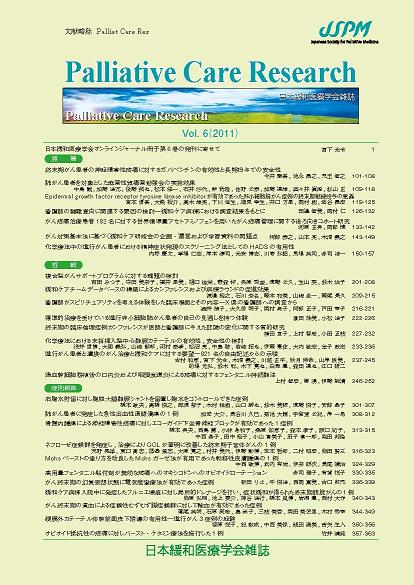Volume 7, Issue 2
Displaying 1-28 of 28 articles from this issue
- |<
- <
- 1
- >
- >|
Original Research
-
2012Volume 7Issue 2 Pages 172-184
Published: 2012
Released on J-STAGE: July 11, 2012
Download PDF (1387K) -
2012Volume 7Issue 2 Pages 185-191
Published: 2012
Released on J-STAGE: July 18, 2012
Download PDF (676K) -
2012Volume 7Issue 2 Pages 192-201
Published: 2012
Released on J-STAGE: July 20, 2012
Download PDF (1068K) -
2012Volume 7Issue 2 Pages 202-208
Published: 2012
Released on J-STAGE: August 13, 2012
Download PDF (497K) -
2012Volume 7Issue 2 Pages 209-217
Published: 2012
Released on J-STAGE: September 14, 2012
Download PDF (1167K) -
2012Volume 7Issue 2 Pages 218-224
Published: 2012
Released on J-STAGE: September 14, 2012
Download PDF (1238K) -
2012Volume 7Issue 2 Pages 225-232
Published: 2012
Released on J-STAGE: October 18, 2012
Download PDF (1043K)
Short Communications
-
2012Volume 7Issue 2 Pages 348-353
Published: 2012
Released on J-STAGE: July 05, 2012
Download PDF (820K) -
2012Volume 7Issue 2 Pages 354-362
Published: 2012
Released on J-STAGE: July 05, 2012
Download PDF (806K) -
2012Volume 7Issue 2 Pages 363-367
Published: 2012
Released on J-STAGE: July 18, 2012
Download PDF (397K) -
2012Volume 7Issue 2 Pages 368-373
Published: 2012
Released on J-STAGE: July 18, 2012
Download PDF (778K) -
2012Volume 7Issue 2 Pages 374-381
Published: 2012
Released on J-STAGE: July 31, 2012
Download PDF (1035K) -
2012Volume 7Issue 2 Pages 382-388
Published: 2012
Released on J-STAGE: July 31, 2012
Download PDF (957K) -
2012Volume 7Issue 2 Pages 389-394
Published: 2012
Released on J-STAGE: August 17, 2012
Download PDF (1092K) -
2012Volume 7Issue 2 Pages 395-402
Published: 2012
Released on J-STAGE: October 18, 2012
Download PDF (549K) -
2012Volume 7Issue 2 Pages 403-407
Published: 2012
Released on J-STAGE: November 12, 2012
Download PDF (765K) -
2012Volume 7Issue 2 Pages 408-414
Published: 2012
Released on J-STAGE: November 12, 2012
Download PDF (1525K)
Case Reports
-
2012Volume 7Issue 2 Pages 530-536
Published: 2012
Released on J-STAGE: July 20, 2012
Download PDF (1257K) -
2012Volume 7Issue 2 Pages 537-540
Published: 2012
Released on J-STAGE: August 06, 2012
Download PDF (644K) -
2012Volume 7Issue 2 Pages 541-544
Published: 2012
Released on J-STAGE: August 21, 2012
Download PDF (434K) -
2012Volume 7Issue 2 Pages 545-549
Published: 2012
Released on J-STAGE: September 14, 2012
Download PDF (1665K) -
2012Volume 7Issue 2 Pages 550-555
Published: 2012
Released on J-STAGE: September 14, 2012
Download PDF (2205K) -
2012Volume 7Issue 2 Pages 556-561
Published: 2012
Released on J-STAGE: September 14, 2012
Download PDF (1161K) -
2012Volume 7Issue 2 Pages 562-567
Published: 2012
Released on J-STAGE: September 21, 2012
Download PDF (1693K) -
2012Volume 7Issue 2 Pages 568-574
Published: 2012
Released on J-STAGE: September 26, 2012
Download PDF (1191K) -
2012Volume 7Issue 2 Pages 575-580
Published: 2012
Released on J-STAGE: September 26, 2012
Download PDF (1279K) -
2012Volume 7Issue 2 Pages 581-584
Published: 2012
Released on J-STAGE: November 12, 2012
Download PDF (636K) -
2012Volume 7Issue 2 Pages 585-590
Published: 2012
Released on J-STAGE: November 12, 2012
Download PDF (964K)
- |<
- <
- 1
- >
- >|
